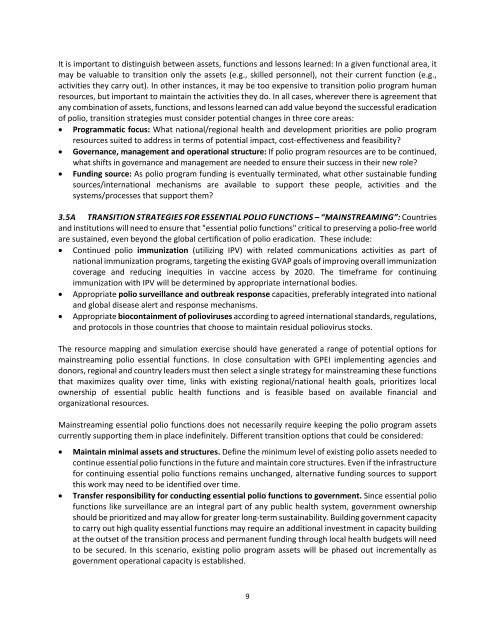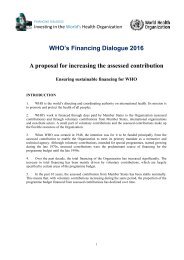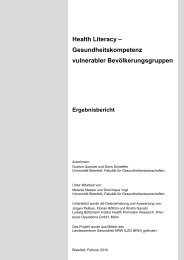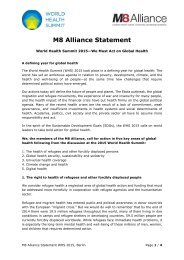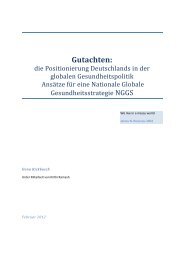POLIO PLANNING
TransitionGuidelinesForPolioLegacy
TransitionGuidelinesForPolioLegacy
You also want an ePaper? Increase the reach of your titles
YUMPU automatically turns print PDFs into web optimized ePapers that Google loves.
It is important to distinguish between assets, functions and lessons learned: In a given functional area, it<br />
may be valuable to transition only the assets (e.g., skilled personnel), not their current function (e.g.,<br />
activities they carry out). In other instances, it may be too expensive to transition polio program human<br />
resources, but important to maintain the activities they do. In all cases, wherever there is agreement that<br />
any combination of assets, functions, and lessons learned can add value beyond the successful eradication<br />
of polio, transition strategies must consider potential changes in three core areas:<br />
• Programmatic focus: What national/regional health and development priorities are polio program<br />
resources suited to address in terms of potential impact, cost-effectiveness and feasibility?<br />
• Governance, management and operational structure: If polio program resources are to be continued,<br />
what shifts in governance and management are needed to ensure their success in their new role?<br />
• Funding source: As polio program funding is eventually terminated, what other sustainable funding<br />
sources/international mechanisms are available to support these people, activities and the<br />
systems/processes that support them?<br />
3.5A TRANSITION STRATEGIES FOR ESSENTIAL <strong>POLIO</strong> FUNCTIONS – “MAINSTREAMING”: Countries<br />
and institutions will need to ensure that "essential polio functions" critical to preserving a polio-free world<br />
are sustained, even beyond the global certification of polio eradication. These include:<br />
• Continued polio immunization (utilizing IPV) with related communications activities as part of<br />
national immunization programs, targeting the existing GVAP goals of improving overall immunization<br />
coverage and reducing inequities in vaccine access by 2020. The timeframe for continuing<br />
immunization with IPV will be determined by appropriate international bodies.<br />
• Appropriate polio surveillance and outbreak response capacities, preferably integrated into national<br />
and global disease alert and response mechanisms.<br />
• Appropriate biocontainment of polioviruses according to agreed international standards, regulations,<br />
and protocols in those countries that choose to maintain residual poliovirus stocks.<br />
The resource mapping and simulation exercise should have generated a range of potential options for<br />
mainstreaming polio essential functions. In close consultation with GPEI implementing agencies and<br />
donors, regional and country leaders must then select a single strategy for mainstreaming these functions<br />
that maximizes quality over time, links with existing regional/national health goals, prioritizes local<br />
ownership of essential public health functions and is feasible based on available financial and<br />
organizational resources.<br />
Mainstreaming essential polio functions does not necessarily require keeping the polio program assets<br />
currently supporting them in place indefinitely. Different transition options that could be considered:<br />
• Maintain minimal assets and structures. Define the minimum level of existing polio assets needed to<br />
continue essential polio functions in the future and maintain core structures. Even if the infrastructure<br />
for continuing essential polio functions remains unchanged, alternative funding sources to support<br />
this work may need to be identified over time.<br />
• Transfer responsibility for conducting essential polio functions to government. Since essential polio<br />
functions like surveillance are an integral part of any public health system, government ownership<br />
should be prioritized and may allow for greater long-term sustainability. Building government capacity<br />
to carry out high quality essential functions may require an additional investment in capacity building<br />
at the outset of the transition process and permanent funding through local health budgets will need<br />
to be secured. In this scenario, existing polio program assets will be phased out incrementally as<br />
government operational capacity is established.<br />
9


